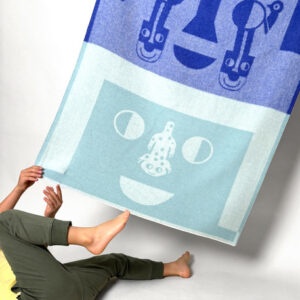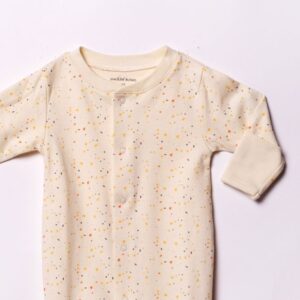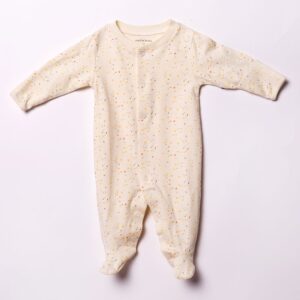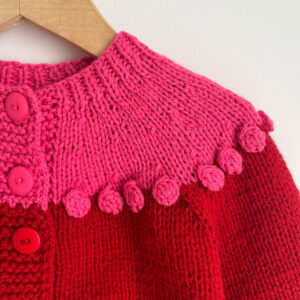6 to 12 months
BABY SLEEP GUIDES: Everything you need to know
BABY SLEEP STAGE:
6 months | 7 months | 8 months | 9 months | 10 months | 11 months | 12 months
SLEEP GOALS:
12-16 hours per day with 3-4 hours of daytime sleep and 10-12 hours at night. Expect 3 naps from 6-9 months and then 2 regular naps by 8-9 months.
Navigating baby's nighttime routines for restful nights and peaceful days
During this stage your baby will start falling into a nap pattern spread out over morning, early afternoon, and late afternoon, giving you some much-needed stability in your day and night. And now that the baby’s hunger hormones drop at night, you’ll probably see that your baby is ready to drop some night feedings and eat more during the day. You might be surprised to hear that your baby is still waking up briefly 4-6 times a night (so do you!), but the good news is once your baby establishes healthy sleep habits, you won’t even notice because they’ll be able to get themself back to sleep.

6 – 12 Months Baby Sleep Guide
Select a topic
- Your baby is now experimenting with new movements, and working hard to sit up and crawl. (Remember that each baby is different and will each show progress at different times.)
- They’re also reaching for objects, responding to sounds, and showing more interest in their surroundings, which might make it hard to stay focused during a feeding. There’s just so many interesting things happening in the world!
- Time to eat! Your baby is ready to start experimenting with solid foods.
- At this stage, separation anxiety may be setting in when mom leaves the room or even when she simply puts the baby down. This is a normal phase in baby’s development, although we know it can break your heart seeing your baby cry.
- Your baby’s body is starting to make internal changes at night that indicate to its brain that it’s time to sleep longer. Their temperature drops during sleep, their metabolism slows and hunger hormones drop so they won’t need to feed as much overnight.
- As your baby reduces night feedings, they will likely increase daytime feedings.
- Babies now have a more mature pattern of sleep, similar to adults, that naturally involves a brief waking after each sleep cycle. Everyone (even you!) wakes 4-6 times every night.
- Babies who seem to “sleep through the night” actually wake multiple times. These babies are called “non-signallers.” They do not cry when they wake, and return to sleep quietly.
- Sleep associations are the things your baby associates with falling asleep. If these sleep associations are not constantly present, then your baby will likely cry during a natural night waking, needing you to replace the sleep association.
- Choose positive sleep associations that can remain constant throughout the night, such as white noise, the coziness of the crib or bassinet, and thumb-sucking. These will help your baby get back to sleep easily.
- Reduce sleep associations that require your assistance. Feeding to sleep, rocking, walking with baby and even pacifiers that need to be replaced during the night will frustrate your baby (and you!)
- Pacifiers can be a negative sleep association if your baby needs it to be replaced during the night and cannot do so independently. By 6-8 months babies can replace their own pacifiers.
- As sleep patterns become more regular, you may start hearing about “sleep training” if you haven’t already. Experts agree that this is a great time to work on changing your baby’s sleep habits and help them get into a healthy sleep routine, even if we disagree on the term “sleep training.”
- Parents and sleep experts alike have mixed feelings about what many commonly call “sleep training.” But giving your child the opportunity to learn the skill of falling asleep is not a bad thing. Here’s why we need to change the language around sleep training.
- No matter what you call it, now is a great time to help your baby understand that falling asleep is pleasant and predictable and allow them to fall asleep with their own skills, in their own way.
- Consistent (and early) bedtimes will help your baby sleep better. Aim to have your baby down for the night between 6 and 8pm.
- Get into a bedtime routine. A simple ritual that includes feeding, bath, gentle massage and pajamas can help signal to your baby that sleep is pleasant… and predictable.
- Babies who are placed into the crib already asleep at bedtime are much more likely to signal or cry when they naturally wake during the night. This is because as humans, we all depend on certain conditions to fall asleep and stay asleep. If you go to sleep with a pillow and you wake up during the night to find that your pillow has fallen, you will pick it up from the floor to go back to sleep. Similarly, if your baby falls asleep in your arms, and they wake up in the middle of the night, they will look for your arms to fall back asleep.
- At this stage, you can expect naps to fall into a pattern of morning, early afternoon, and late afternoon.
- As your baby’s sleep patterns become more regular, you will notice the need for:
– A first nap around 8:30 or 9am. This nap might be a continuation of night sleep and sets the rhythm of the day. Ideally you will want to wake your baby before 11am to prevent this early nap from affecting the second nap of the day.
– A second nap around 12:30 or 1pm. At this age your baby can be active 2.5 to 2.75 hours awake in between naps.
– A third nap that usually will happen around 2 hours after the second nap ended. You might notice your baby will fight this nap as he gets closer to 8 months old.
Check out a suggested 6-month baby sleep schedule. - It’s ok to wake your baby from a nap, especially if it’s time to feed. At this stage, make sure you feed your baby every 3-4 hours during the day.
- At rockin’BLINKS we are fans of Dr. Emmi Pikler’s approach to allow motor development to unfold naturally, at its natural pace, without interference.
Babies need a lot of space and opportunities to move freely in order to practice new abilities as they grow. - Prioritize floor-time during your baby’s awake hours, and let them explore the objects around them and find new ways to move their bodies. Make sure your baby is in a safe place, you might be surprised how much they can move!
- Your baby will discover how to roll from back to tummy and from tummy to back, and eventually, they will find the sleep position they feel most comfortable in. At first, these new movement abilities might keep them up at night, as they get stuck on their bellies or stand up without knowing how to sit back down. Soon your baby will feel more comfortable moving around and will learn to go back to sleep after having a little fun.
- Always follow AAP recommendations on safe sleep and keep putting your baby to sleep on their back every time you put them to sleep.
- During your baby’s bedtime routine, separate feeding from sleep. Put feeding at the start rather than the end of your routine. If your baby has been feeding until they’re asleep, it’s time to guide your baby into a different way to fall asleep.
- Follow your pediatrician or health care provider’s advice about dropping night feedings. If your baby still needs to feed at night, you might see 1 to 2 night feedings sometime after midnight.
- Most night wakings are no longer driven by hunger, though a baby who is regularly fed at night will continue to expect to be fed.
- Keep the bedroom pitch black if possible. If a nightlight is needed to help you during night wakings, keep it dim. Red or orange-hued light is less sleep-disruptive than blue or white light.
Utilize white noise. It’s soothing, and can also help block disruptive noises. (PS: Volume shouldn’t be louder than a bathroom shower!) - Temperature matters. We sleep best in a cool room. 68-72 degrees is the recommended temperature for infants.
- Swaddles should no longer be used at this age. A sleep sack can be used for warmth if needed; do not use loose blankets.
- Harries, V. (2015). Infant Sleep and Night Feeding Patterns During Later Infancy: Association with Breastfeeding Frequency, Daytime Complementary Food Intake, and Infant Weight. Breastfeeding Medicine, (5), 246–252. https://doi.org/10.1089/bfm.2014.0153
- Staton S., Rankin, P., Harding, M., Smith, S., Westwood, E., Lebourgeois, M. K., & Thorpe, K. J. (2019). Many naps, one nap, none: A systematic review and meta-analysis of napping patterns in children 0-12 years. Sleep Medicine Reviews. https://doi.org/10.1016/j.smrv.2019.101247
- Mindell, J. A., Composto, J., Lee, C., Bhullar, B., & Walters, R. (2014). Development of infant and toddler sleep patterns from real world data on a mobile app.(June), A312. https://doi.org/10.1111/jsr.12414
We are here to Help
At Rockin’ Blinks our certified sleep consultants will help you:

- Understand your baby’s sleep and how it develops during the first year of life
- Find a sleep schedule that works for your and your baby.
- Guide you and support you during a process of sleep training.
- Get in contact with founder of Rockin’Blinks, Lola Sánchez Liste, and book her sleep coaching services for your family.
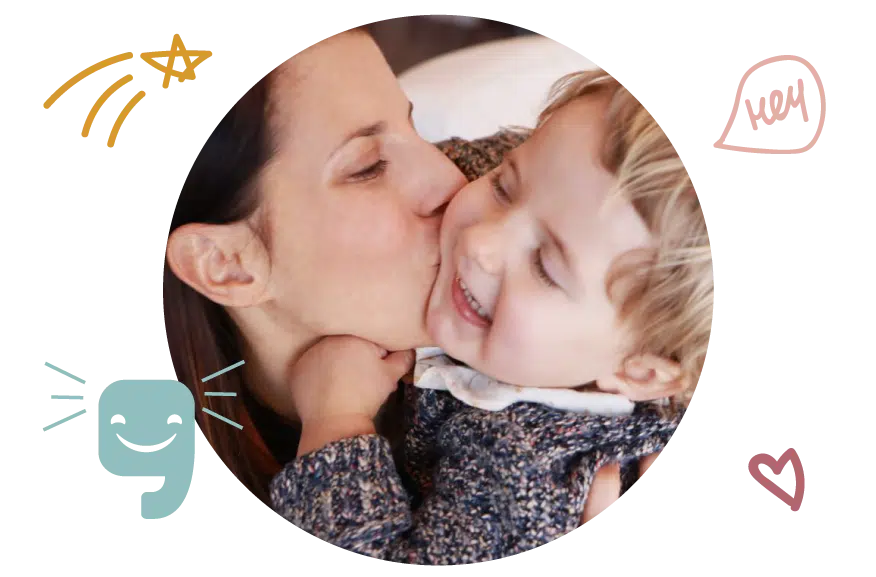
Lola Sánchez Liste is the CEO and founder of Rockin’Blinks.
PRODUCTS COLLECTION
Rockin’Blinks Sleepwear Collection
-
NEW IN
Baby Alpaca Blanket – Blue / Light blue
Rated 0 out of 5$240.00Original price was: $240.00.$179.99Current price is: $179.99. Add to cart -
Rockin'Blinks Collection
Baby Footie Onesie Pima Cotton – Litoral Dreams Capsule – Piedras Birch
Rated 0 out of 5$52.00Original price was: $52.00.$42.00Current price is: $42.00. Add to cart -
Rockin'Blinks Collection
Baby Footie Onesie Pima Cotton – Litoral Dreams Capsule – Piedras Birch
Rated 0 out of 5$52.00Original price was: $52.00.$42.00Current price is: $42.00. Add to cart -
Rockin'Blinks Collection
Hand Knit Cardigan – Garland – Fuchsia/Red
Rated 0 out of 5$65.00Original price was: $65.00.$45.00Current price is: $45.00. Add to cart

